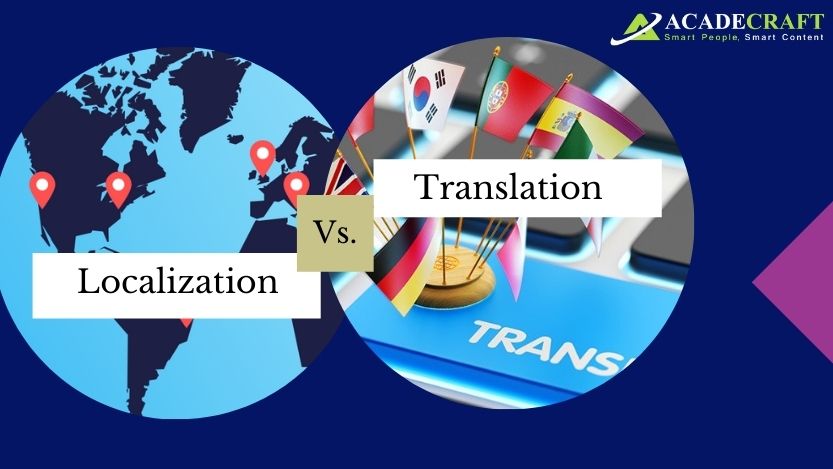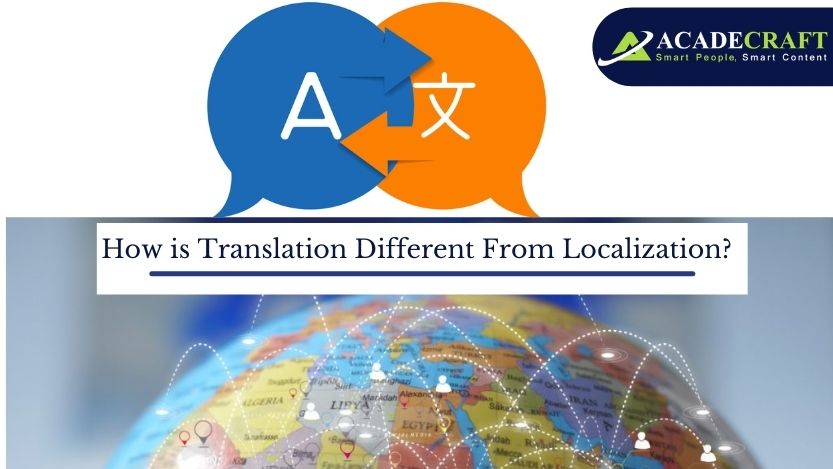
In today?s world of online business growth, ?Translation? and ?Localization? are leaves of the same branch. Although translation has been here for ages, localization emerged as an upgraded version of it. It started being under the limelight more in the digitally progressive world. While?language translation services?provide the fundamental transformation from one language to another, localization takes it a step ahead.
Most companies today are looking to expand their market reach beyond geographical boundaries. And in this case, both translation and localization solutions have individual roles to play in globalization.
But then, the same question comes back with time. Are ?Translation? and ?Localization? the same, or are the two different?
In this blog, let us talk about it in detail to know how the two work in their own fields.
Defining Translation and Localization
If companies want to build a solid business reach globally, it is obvious to use translation and localization services.?
What do Translation services do?
Translation, especially eLearning translation services, looks towards converting a source language to a target language. It is the simple process of rendering the text from one language to another to make it understandable. Although it is no hardcore translation rules, yet the translated version must be coherent.
What do Localization services do?
Localization is all about adapting and evolving content to make it relevant to a particular section of people. Localization must respect the local approach of the content and shape it up accordingly. It is a comprehensive process and one of its critical components in translation.
Therefore, localization adapts a product, service, or any subject to meet the target region?s cultural and linguistic requirements.
Translation Begins the Whole Process
If your company is looking to grow its market reach beyond the country lines, translation is the first step. From a user manual to product description, it all starts with translation.
Through translation, the audience gets an idea of the primary textual content of any foreign product or service.
Localization Gets Deeper into It
Localization takes the process deeper by making the content and its peripherals comfortable for the target audience. It adapts and uses multiple techniques to ensure that a company mixes with the local audience. Localization takes formal and informal settings while considering the relevant ways to localize a website. It gets deeper into connecting with the audience not solely through the written words but also by connoting emotions.
Localization Involves Page Formatting
The website?s page design layout and font styles matter greatly in localization. Font styles must adapt to different target languages and their unique writing styles. Similarly, even for page layout and structure, localization has a vital role to play.
For example, if your company is looking to expand business in any Arabic nation, the page design needs a change. English starts from left to the right of a sentence but precisely the opposite for Arabic.
Moreover, the word size of an English word gets increased in its Russian or German counterparts. Therefore, without the localization of the company?s website, it will be challenging to connect with the local audience.

Translation Is Neutral to Cultural Changes
Translation services do not care about the cultural and ethnic changes between two places. It just converts the original language into the target language without making any change to the initial meaning.
When a company translates any content like a training manual, they do not want to change its meaning. It is precisely evident in eLearning translation services. The initial content and the final content are never different in the overall sense. While it is a plus point of translation, it also shows its limitations compared to localization.
Localization Focuses on Cultural Changes
Localization is incomplete without tweaking and localizing the content to make it relevant to a particular culture or ethnicity. Localization techniques understand the market and its audience thoroughly before working on them.
If your organization wants to compete against the best brands of a target location, localization is the answer. Alone translation will cast no spell as it isn?t a dynamic process like localization. Translation does not possess the abilities to fulfil the requirements of diverse customers and markets.
For example, if your brand is opening up a store in India, they should look for local cultural dates. Providing discounts on St Patrick?s Day or Veterans Day will not work at all, but Republic or Christmas days will.
Translation Matches Well with Technical Content
The one place where there is no replacement for translation services is in technical subjects. Subjects like Law, Science, Medical, Finance, and Research require zero localization. These subjects are filled with technical terminologies that only professional translators and subject experts can handle. Translating technical content requires in-depth knowledge of the matter in both languages. This is something that localization cannot mend because one does not need to localize a scientific term or expression.
Localization Connects Well With Emotive Content
Localization includes changing the website and marketing content in a way that appeases the local audience. Therefore, we can conclude that it has a strong relation with dynamic content. Whether it is marketing or website content, localization adds regional specificity and relevance.
Localization Is Not Only About Language
Even beyond emotive content, localization has its arms spread further. From text names, currencies, cultural references to idioms and other expressions, localization is essential.
Here are some of the most-used places where companies use localization -
Measurement Localization
Any measurement information on your product description must be localized. It is essential to take care of the Imperial and Metric measurement systems.
Currency Localization
Selling an American energy drink in the UK might not need to localize the flavour, but the currency needs. The company needs to change the price tags and localize them to match the target region?s currency.
Date Format Localization
Failing to change this can give rise to unwanted confusion. Suppose your company is looking to crack a flash sale on 10/5/2025. People from the US will understand that it is on 5th October while UK customers will take it on 10th May. There goes the necessity of localization where the date formats mean different things.
Companies need to understand how localization and?language translation services?both play significant roles towards a common motive. Both of them target to make the company?s content, product, and services understandable and culturally relevant for the target audience.?
Share